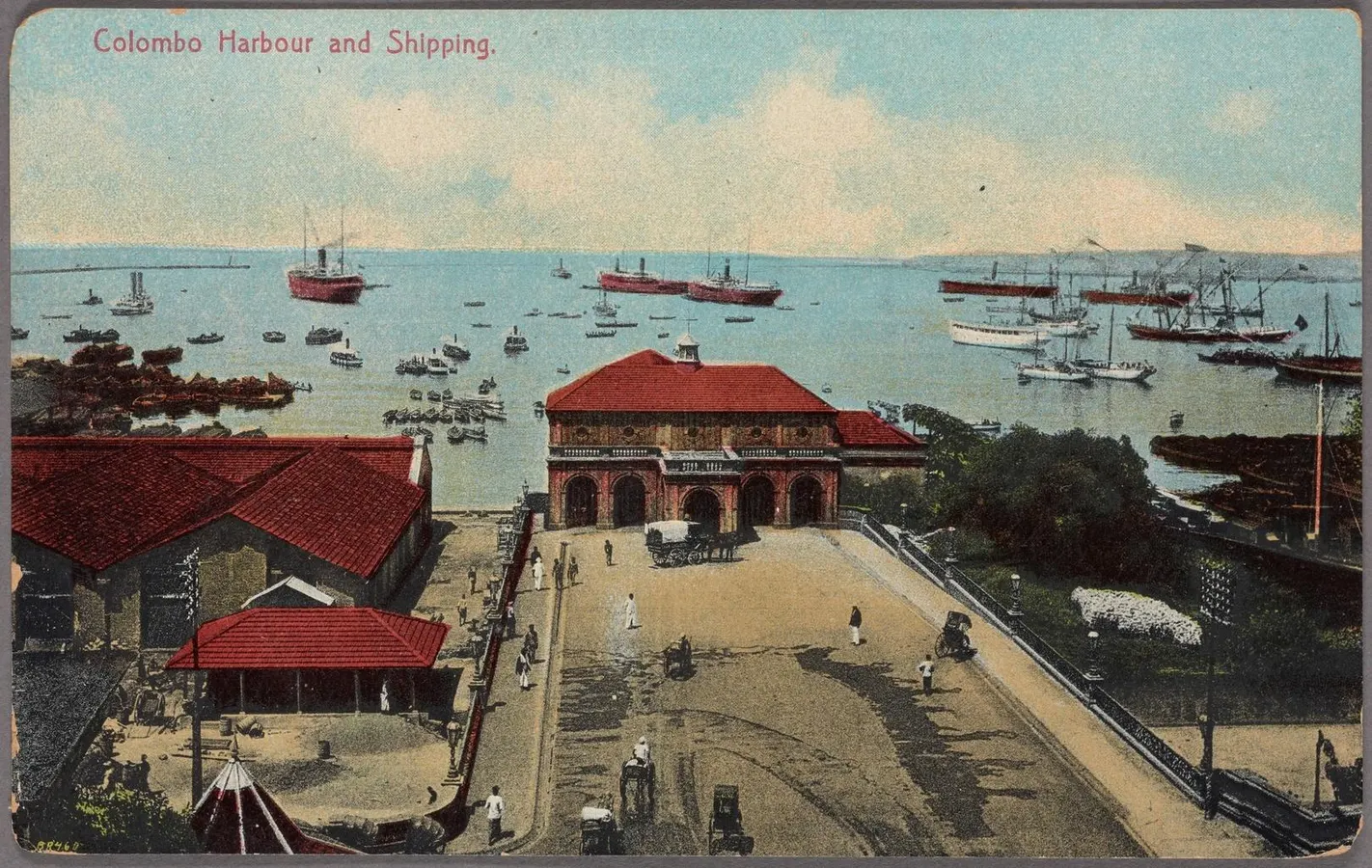By Contributor,Daniel Scheffler,Rainer Krack
Copyright forbes

Illustrated postcard of a bird’s eye view of piers and warehouses in Colombo Harbor, or the Port of Colombo, with boats and ships in the background, Colombo, Sri Lanka (formerly Ceylon), published by A.W.A. Plate and Co, 1912. From the New York Public Library. (Photo by Smith Collection/Gado/Getty Images)
Getty Images
I arrived in Sri Lanka hungry in every sense—stomach first, eyes and mind racing to keep pace. Alongside my husband and our two best friends, we stepped into a world alive with scent and color. Colombo struck like a sudden awakening: coconut smoke spiraling into the sky, chilies piercing the air, knives tapping a rhythm I could dance to. Every scent carried history; every bite traced centuries of trade, colonization, and reinvention.
We traveled with Audley Travel, whose knowledge opened doors we might never have found alone. Without them, the markets, kitchens, and highlands could have stayed out of reach—moments glimpsed, not fully lived. Instead, we dove in, tasting, touching, inhaling: participants, not tourists.
The first bite was revelation. Coconut, curry leaves, cardamom, chili—they were fingerprints of civilizations. Arab, Indian, and Chinese traders arrived as early as the second century AD, introducing spices and techniques that persist today. Centuries later, Portuguese, Dutch, and British colonizers left their marks: lamprais, Malay sambals, afternoon teas. Every flavor is a conversation, and Sri Lanka insists you listen.
Sri Lanka Highlands: Tea, Mist, and Relentless Labor
Tea estates are being pictured in Nuwara Eliya, Sri Lanka, on March 3, 2024. Tea, an aromatic beverage, is being prepared by pouring hot or boiling water over cured or fresh leaves of Camellia sinensis, an evergreen shrub native to East Asia, likely originating in the borderlands of southwestern China and northern Myanmar. Tea is also occasionally being made from the leaves of Camellia taliensis. (Photo by Thilina Kaluthotage/NurPhoto via Getty Images)
NurPhoto via Getty Images
We wound into the hills, leaving Colombo’s chaos behind. Roads switchbacked through valleys, mist clinging to slopes as if it had purpose. Acres of tea vanished and reappeared with each turn. Waterfalls winked; peaks jutted through clouds, daring us to keep pace. This is Sri Lanka’s tea country, uncompromising and vivid.
We stayed at Camellia Hills, a quiet retreat outside Nuwara Eliya. Slopes rose sharply, impossible to ignore. From there, we visited Dunkeld Estate in Hatton, perched up the slope from the Castlereagh Reservoir. Tea climbed the hills in neat, relentless rows, a living quilt planted decades ago by British planters, shaping the island’s global reputation.
DICKOYA, SRI LANKA – APRIL 2: A poster showing how Ceylon tea is processed is pictured at the Dunkeld Tea Estate operated by MJF Holdings Ltd’s Dilmah Tea on April 2, 2019 in Dickoya, near Hatton in the central province of Sri Lanka. (Photo by Yuriko Nakao/Getty Images)
Getty Images
Inside the factory, machines hummed as leaves withered, rolled, oxidized. Wet earth mingled with the fragrance of fresh tea. First sip: bright, floral, immediate. Second: soft, lingering, carrying soil, rain, altitude, centuries of labor. Each cup embodies the hills themselves—a mindful practice you can drink. For a tea lover, this is devotion distilled.
Meals at Camellia Hills demanded the same attention: red rice, lentil curries, coconut vegetables, delicate sambals. The highlands slowed us. Every bite asked for focus. Buddhist principles hovered: impermanence, gratitude, care. Eating here is not casual; it requires presence. You notice the labor, the land, the people behind every grain of rice.
By Train to Kandy: Markets That Reflect Life in Sri Lanka
Kandy is Sri Lanka’s second biggest city with a population of around 170,000 and is the cultural centre of the whole island. For about two centuries (until 1815) it was the capital of Sri Lanka. (Photo by: Rainer Krack/Pictures From History/Universal Images Group via Getty Images)
Pictures From History/Universal Images Group via Getty Images
The train rattled through misted hills, tea plantations, valleys flashing past, mountains rising and sloping with calm insistence. Kandy emerged, pulsing with color, noise, life.
The market hit like a shockwave. Guided by Anjalee Fernando from Jetwing Adventures, we threaded narrow aisles fragrant with cumin, coriander, turmeric, and chili. Fish, meat, and chicken lay raw, fresh, some still bleeding out at my feet. My Western brain flinched. My stomach threatened mutiny. Then I laughed. You have to let go. Life here is unfiltered, messy, alive.
Baskets overflowed with fruits I had never seen: bilimbi, puckering the tongue; sapodilla, molten gold on a spoon; wood apple, tangy and medicinal. Rambutans burst crimson; mangosteens, velvet-sweet; velvet apples left a quiet astringence. Each taste demanded patience, curiosity, full presence.
Curries arrived in parade formation: coastal crab, fiery and unapologetic, spoke of maritime trade; jackfruit, tender but meaty, revealed local ingenuity. Coconut-gravy vegetables, lime-sprinkled sambals, fried shallots, crackling curry leaves—all layered, deliberate, insistent. Each dish carried history: Arab traders’ spices, Portuguese chilies, Dutch preservation, local innovation. Every bite was meditation, adaptation, resilience.
“You haven’t tasted food properly until you’ve tasted it here,” Anjalee said, handing me fresh coconut. She was right.
Kamatha and the Rice Paddies: Storms, Lanterns, and Ritual in Sri Lanka
On this epicurean adventure you will sample traditional dishes, explore old world ingredients and even work with home cooks and their favourite recipes. You will learn ; how the traditions of a Kingdom are reflected in the myriad of fragrant spices and seasonings, about the utensils still in use after 2000 years and of the preparation of food in hand made clay pots and open wood fires at a whole different taste.
Uga Ulagalla
Further inland, at Uga Ulagalla near Anuradhapura, Kamatha rises from the paddies stitched from the earth itself. Open-air pavilion, clay walls, thatched roof—centuries of care embedded in every corner. Rice paddies swayed under clouds thick enough to drown in, rain hammering sheets against the roof. Lanterns flickered; shadows leaned across green stalks like they had secrets to tell.
Our cooks, Diluka Niroshani and her sister Manel Kanchani, welcomed us to a 28-course feast drawn from recipes preserved across generations. Vegetables from the farm, lake fish, free-range meats, traditional breads, rice—the backbone of the meal. These dishes reflect the ingenuity of Sri Lanka’s people: combining indigenous produce with flavors brought by traders, then refined and treasured within families.
One dish stood out: Kurakkan Thalapa. Made from finger millet flour, cooked gently with water and coconut milk until soft, it becomes a comforting meal when paired with rich beef curry. Diluka shared why it is so close to her heart: “My mother and grandmother used to cook this for me when I was a child. It carries not just flavor but warm memories of family and home. They taught me how to prepare it—a skill I proudly carry into my cooking today.”
Growing up, Diluka and Manel learned not just recipes but values: honoring every ingredient, avoiding waste. Extra lime slices became lime pickle. Abundant mangoes were sliced and dried, preserved for months. These traditions of resourcefulness, preservation, and mindfulness echo in every dish they serve, connecting guests to the land, the seasons, and ancestors.
“We cook to honor the ingredients,” Diluka said. “Every spice, every technique has a story. Preparing it connects us to the land and our ancestors.”
Manel added, “Eating here is about presence. About care. We want guests to feel it.”
And we did.
Diluka and her sister Manel are the master chefs behind the restaurant Kamatha – they have an open fire kitchen using traditional pots and techniques.
Uga Ulagalla
Coconut grated, curry leaves hissed, hoppers puffed and sank, sambals glimmered. Brinjal moju, mutton curry, fresh fried lake fish, string hoppers, corn pittu, three varieties of rice. Desserts—habalapethi aggala, lavariya—finished with steaming ginger tea sweetened with jaggery. Every bite was alive. Not dinner. Homecoming.
The storm did not just soak the paddies—it carried scent, sound, rhythm into the meal. Buddhist mindfulness again: impermanence, attention, gratitude. Every flicker of lantern light demanded presence. Sri Lanka’s magic thrives in the ordinary: wet soil, crackling leaves, spice swirling in the air. The country doesn’t just feed you—it reveals you.
Sri Lanka Offers Fine Dining At GINI
Returning to Colombo, we sought the meeting point of familiar and inventive. Inspired by the Sri Lankan word Gindara, meaning “fire,” GINI is a family-owned restaurant on a mission to elevate local cuisine. Coconut, curry leaves, jaggery, cinnamon, cloves—lamprais, desserts, sauces. Curry layered, coconut crisped, spice calibrated. Tradition respected, reimagined.
“For us, Sri Lankan cuisine goes beyond food. Hospitality, passion, sharing dishes—that’s what it’s about,” co-owner Shanil Dayawansa said. “We cook over a live fire. Local, fresh, fire. Depth you can’t replicate in a conventional kitchen.”
And at GINI you are reminded through your plate.Sri Lanka’s cuisine is a map of its past: traders, colonizers, plus local ingenuity.” Every hopper, sambal, sip of tea carries centuries of knowledge. Fruits, spices, coconut, curry leaves—they demand attention, reverence, curiosity.
Fire-cooked and seasonally inspired, their cuisine is a journey that blends warmth, tradition, and a touch of the unexpected, defining what a fine dining restaurant in Colombo truly feels like.
Sri Lanka Teaches Presence
Traveling through Sri Lanka, I realized the country does more than feed you—it enshrouds you. Markets hum with life, kitchens pulse with tradition, highland mist carries rain and tea. Every bite layered with history, culture, care. Bold, layered, restorative, humble, profound. You do not taste it—you inhabit it.
And at the end, when rain washes the paddies, spice hangs thick in the market, and hills vanish into mist, one truth remains: Sri Lanka is simply incredible. It slows you down, demands attention, teaches patience, and forces you to meet yourself in unexpected ways. The food, the hills, the rituals, the people—they teach presence, patience, and joy. Every bite, every step, every taste is a lesson.
Sri Lanka teaches you to live.
Editorial StandardsReprints & Permissions



